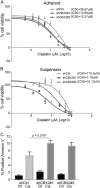CBX2 identified as driver of anoikis escape and dissemination in high grade serous ovarian cancer
- PMID: 30478317
- PMCID: PMC6255906
- DOI: 10.1038/s41389-018-0103-1
CBX2 identified as driver of anoikis escape and dissemination in high grade serous ovarian cancer
Abstract
High grade serous ovarian carcinoma (HGSOC) is often diagnosed at an advanced stage. Chromobox 2 (CBX2), a polycomb repressor complex subunit, plays an oncogenic role in other cancers, but little is known about its role in HGSOC. We hypothesize that CBX2 upregulation promotes HGSOC via induction of a stem-like transcriptional profile and inhibition of anoikis. Examination of Gene Expression Omnibus (GEO) datasets and The Cancer Genome Atlas (TCGA) established that increased CBX2 expression conveyed chemoresistance and worse disease-free and overall survival. In primary HGSOC tumors, we observed CBX2 expression was significantly elevated compared to benign counterparts. In HGSOC cell lines, forced suspension promoted CBX2 expression. Subsequently, CBX2 knockdown inhibited anchorage-independent proliferation and potentiated anoikis-dependent apoptosis. Furthermore, CBX2 knockdown re-sensitized cells to platinum-based chemotherapy. Forced suspension promoted increased ALDH activity and ALDH3A1 expression and CBX2 knockdown led to a decrease in both ALDH activity and ALDH3A1 expression. Investigation of CBX2 expression on a HGSOC tissue microarray revealed CBX2 expression was apparent in both primary and metastatic tissues. CBX2 is an important regulator of stem-ness, anoikis escape, HGSOC dissemination, and chemoresistance and potentially serves as a novel therapeutic target.
Conflict of interest statement
The authors declare that they have no conflict of interest.
Figures






Similar articles
-
Loss of CBX2 causes genomic instability and Wnt activation in high grade serous ovarian carcinoma cells.Mol Carcinog. 2023 Apr;62(4):479-492. doi: 10.1002/mc.23500. Epub 2023 Jan 9. Mol Carcinog. 2023. PMID: 36621979
-
Targeting Fatty Acid Oxidation to Promote Anoikis and Inhibit Ovarian Cancer Progression.Mol Cancer Res. 2020 Jul;18(7):1088-1098. doi: 10.1158/1541-7786.MCR-19-1057. Epub 2020 Mar 20. Mol Cancer Res. 2020. PMID: 32198139 Free PMC article.
-
Tumor-Intrinsic Activity of Chromobox 2 Remodels the Tumor Microenvironment in High-grade Serous Carcinoma.Cancer Res Commun. 2024 Aug 1;4(8):1919-1932. doi: 10.1158/2767-9764.CRC-24-0027. Cancer Res Commun. 2024. PMID: 38984891 Free PMC article.
-
Studying platinum sensitivity and resistance in high-grade serous ovarian cancer: Different models for different questions.Drug Resist Updat. 2016 Jan;24:55-69. doi: 10.1016/j.drup.2015.11.005. Epub 2015 Nov 26. Drug Resist Updat. 2016. PMID: 26830315 Review.
-
Epigenetic Mechanisms and Therapeutic Targets in Chemoresistant High-Grade Serous Ovarian Cancer.Cancers (Basel). 2021 Nov 29;13(23):5993. doi: 10.3390/cancers13235993. Cancers (Basel). 2021. PMID: 34885103 Free PMC article. Review.
Cited by
-
Immobilization rapidly selects for chemoresistant ovarian cancer cells with enhanced ability to enter dormancy.Biotechnol Bioeng. 2020 Oct;117(10):3066-3080. doi: 10.1002/bit.27479. Epub 2020 Jul 9. Biotechnol Bioeng. 2020. PMID: 32589792 Free PMC article.
-
The Prognostic Value of the Chromobox Family in Human Ovarian Cancer.J Cancer. 2020 Jul 6;11(17):5198-5209. doi: 10.7150/jca.44475. eCollection 2020. J Cancer. 2020. PMID: 32742466 Free PMC article.
-
Comprehensive analysis of the prognosis for chromobox family in gastric cancer.J Gastrointest Oncol. 2020 Oct;11(5):932-951. doi: 10.21037/jgo-20-208. J Gastrointest Oncol. 2020. PMID: 33209489 Free PMC article.
-
Proteasomal degradation of polycomb-group protein CBX6 confers MMP-2 expression essential for mesothelioma invasion.Sci Rep. 2020 Oct 7;10(1):16678. doi: 10.1038/s41598-020-72448-y. Sci Rep. 2020. PMID: 33028834 Free PMC article.
-
Multi-Omic Approaches Identify Metabolic and Autophagy Regulators Important in Ovarian Cancer Dissemination.iScience. 2019 Sep 27;19:474-491. doi: 10.1016/j.isci.2019.07.049. Epub 2019 Aug 6. iScience. 2019. PMID: 31437751 Free PMC article.
References
Grants and funding
LinkOut - more resources
Full Text Sources
Other Literature Sources

